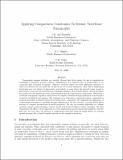Applying Compactness Constraints to Seismic Traveltime Tomography
Author(s)
Ajo-Franklin, Jonathan B.; Minsley, Burke J.; Daley, T. M.
DownloadAjo-Franklin_tomography06.pdf (251.5Kb)
Other Contributors
Massachusetts Institute of Technology. Earth Resources Laboratory
Metadata
Show full item recordAbstract
Tomographic imaging problems are typically ill-posed and often require the use of regularization techniques to guarantee a stable solution. Minimization of a weighted norm of model length is one commonly used secondary constraint. Tikhonov methods exploit low-order differential operators to select for solutions that are small, flat, or smooth in one or more dimensions. This class of regularizing functionals may not always be appropriate, particularly in cases where the anomaly being imaged is generated by a non-smooth spatial process. Timelapse imaging of flow-induced seismic velocity anomalies is one such case; flow features are often characterized by spatial compactness or connectivity. We develop a traveltime tomography algorithm which selects for compact solutions through application of model-space iteratively reweighted least squares. Our technique is an adaptation of minimum support regularization methods previously developed within the potential theory community. We emphasize the application of compactness constraints to timelapse datasets differenced in the data domain, a process which allows recovery of compact perturbations in model properties. We test our inversion algorithm on a simple synthetic dataset generated using a velocity model with several localized velocity anomalies. We then demonstrate the efficacy of the algorithm on a CO2 sequestration monitoring dataset acquired at the Frio pilot site. In both cases, the addition of compactness constraints improves image quality by reducing spatial smearing due to limited angular aperture in the acquisition geometry.
Date issued
2006Publisher
Massachusetts Institute of Technology. Earth Resources Laboratory
Series/Report no.
Earth Resources Laboratory Industry Consortia Annual Report;2006-09